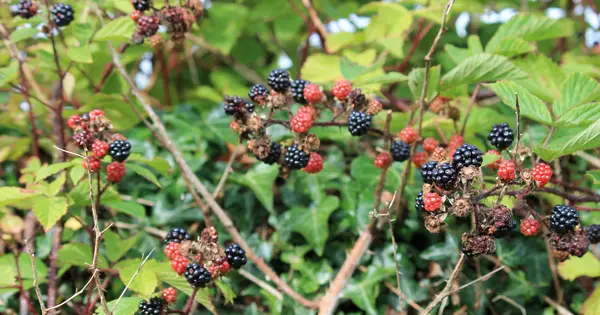Vines, or grape vines, didn’t reach the shores of Ireland until the Romans introduced wine around 2000 years ago.
Back to trees
Back to Celtic mythology
The bramble, however, is native to the cool climate of Northern Europe, shares the winding characteristics and bares sweet fruit like the vine. This is why the ogham muin could represent either the vine or the bramble.
Since the introduction of wine to Ireland, the country has had a long love affair with both the plant and the drink, believed to loosen the tongue, release inhibitions and consumed by seers to stimulate prophecy.
Wine

During the 9th century, Viking traders who had already settled in the Loire Valley would bring wine to Ireland and it later became used as a tribute to the king; one ton of wine for each day in the year.
Wine was a big part of the feast culture of the old chieftains and, in later years it was Irish emigrants escaping English rule, known now as ‘Winegeese’ who were responsible for introducing vineyards to many countries throughout the world.
In mythology, the vine is sacred to the Greek gods Dionysus and Osiris and the Roman God Bacchus. The vine is known as the tree of joy, exhilaration and wrath and is believed to be one of the sacred woods burned on the Beltane fires in Britain and Ireland representing joy and happiness.
Romans and Greeks celebrated the vine tree
The Romans and Greeks also had a festival involving the vine called Vinalia Rostica which celebrated and gave thanks the first harvest.
In the Celtic tree calendar the vine represents harvest time and the beginning of Autumn. The Autumn Equinox and festival of Mabon falls within the vine month, a festival of thanksgiving and learning.
In Christian belief, wine was the drink shared by Christ at the last supper and is still consumed in churches for this reason. It was the monasteries who cultivated the vine in Ireland and the British Isles for it could not grow in the wild as brambles could.
The bramble bush

Muin, M – The vine represents the eleventh letter in the ogham alphabet, muin, and the tenth month in the Celtic tree calendar.
Christians had a very different story involving the Bramble. It was that when the devil was thrown out of heaven he landed on a bramble bush. This made him so angry that he cursed the plant and spat upon it.
Because of this, it was wrong to eat the fruit of the bramble after Michaelmas, September 29th, because the devil enters them.
This belief had a few variations. In Celtic Brittany it was said to be because of the fairies, and, in Wales, simply because they were poisonous by that time.
This is not actually the case, however, certain insects do begin to lay their eggs on the ripened fruit during October which could well have been the cause of some stomach upsets.
Bramble wood was used in basket weaving and to make beehives, in a similar way to willow and bramble was often planted with hawthorn, sometimes known as the fairy tree, in hedgerows in order to bind a hedge.
Perhaps the close association to these very pagan trees and old ways is what made the Christians link the Bramble to a story about the devil.
More on Celtic trees folklore
Ireland – the principal preserver of Celtic Mythology
